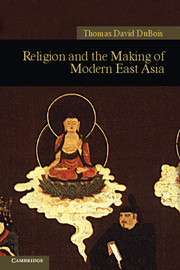Book contents
- Frontmatter
- Contents
- List of Boxes, Figures, and Maps
- Preface
- 1 In the beginning: Religion and history
- 2 Ming China: The fourteenth century's new world order
- 3 The Buddha and the shōgun in sixteenth-century Japan
- 4 Opportunities lost: The failure of Christianity, 1550–1750
- 5 Buddhism: Incarnations and reincarnations
- 6 Apocalypse now
- 7 Out of the twilight: Religion and the late nineteenth century
- 8 Into the abyss: Religion and the road to disaster during the early twentieth century
- 9 Brave new world: Religion in the reinvention of postwar Asia
- 10 The globalization of Asian religion
- Glossary
- Timeline of dynasties and major events
- Suggestions for further reading
- Index
7 - Out of the twilight: Religion and the late nineteenth century
Published online by Cambridge University Press: 05 June 2012
- Frontmatter
- Contents
- List of Boxes, Figures, and Maps
- Preface
- 1 In the beginning: Religion and history
- 2 Ming China: The fourteenth century's new world order
- 3 The Buddha and the shōgun in sixteenth-century Japan
- 4 Opportunities lost: The failure of Christianity, 1550–1750
- 5 Buddhism: Incarnations and reincarnations
- 6 Apocalypse now
- 7 Out of the twilight: Religion and the late nineteenth century
- 8 Into the abyss: Religion and the road to disaster during the early twentieth century
- 9 Brave new world: Religion in the reinvention of postwar Asia
- 10 The globalization of Asian religion
- Glossary
- Timeline of dynasties and major events
- Suggestions for further reading
- Index
Summary
Fists of Justice and Harmony: Christian mission and the last stand of Chinese traditionalism
Over the nineteenth century, the Qing gradually lost the upper hand in dealing with the Western powers. The change resulted not from religion, but from commerce. As the Iberian powers went into decline during the late 1700s, Britain emerged as China's greatest European trading partner. Initially, this trade was conducted entirely on Chinese terms: it was bottlenecked through the single port of Canton and consisted almost entirely of an exchange of Chinese tea for British silver. The tea trade was so massive and so valuable that even a low import duty of 12.5 percent provided a tenth of all British government revenue. But it was not sustainable. After a long series of behind-the-scenes negotiations over court protocol, British envoys finally met the aging Qianlong emperor in 1793. To the request for more equal terms of trade came the emperor's famously dismissive response: “We possess all things. I set no value on strange or ingenious objects, and have no use for your country's manufactures.”
By the early 1800s, British firms (including such august names as Jardine Matheson) were making up their losses by illegally trading opium up and down the coast, and by 1840 the tension between the two countries reached the point of war.
- Type
- Chapter
- Information
- Religion and the Making of Modern East Asia , pp. 142 - 160Publisher: Cambridge University PressPrint publication year: 2011

